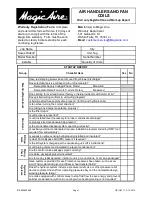
BA-CFD-RLM-ATEX 4.0
– 05/2019
English
EN-16/24
8.2. Electrical connection of the motor
Figure 8-1 Connection box
1.
Fit inspection switch if applicable.
2.
Connect feed line to fan or service switch.
3.
Connect motor as shown on connection diagram supplied.
4.
Ensure that all the electrical safety devices have been fitted and
connected.
1 = Connection box
8.3. Motor Protection
Protect motors against overload in accordance with EN 60204-1.
Speed controlled, pressure resistant encapsulated motors, equipped with
certified PTC-thermistors have to be operated – in the case of explosion
proof application – with an ATEX certified tripping unit, which switches off
the fan at a surface temperature of 125 ° C!
Only motors conforming to the corresponding ATEX – category of the fan
are permitted.
Motor protection switches must be set to the nominal motor current (see
type plate). A higher setting value is not admitted!
Respect the te-time for overload protection indicated on the motor type
plate.
CAUTION
Fuses or circuit breakers do not provide sufficient motor protection.
Damage due to insufficient motor protection invalidates the
manufacturer’s guarantee.
Note In all cases the power limitations provided by the existing power supply
company must be taken into account.
If plant conditions necessitate a direct start the suitability of the fan design
must be confirmed with Nicotra Gebhardt. Fans with high inertia impellers
can take over 6 seconds to reach top running speed. In these cases heavy
duty motor protection relays or bimetal relays must be provided.
8.4. Carrying out a Test Run
DANGER!
Risk of injury from rotating impeller!
Never reach into the impeller when the fan is open.
1.
Take measures to prevent the centrifugal fan from being switched on
accidentally
2.
Clear the ducting system and fan of all foreign bodies (tools, small parts,
construction waste, etc.
3.
Close all the inspection openings.
4.
Switch on the fan and check the direction of rotation of the impeller by
comparing it with the arrow on the fan indicating the direction of rotation.















































